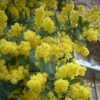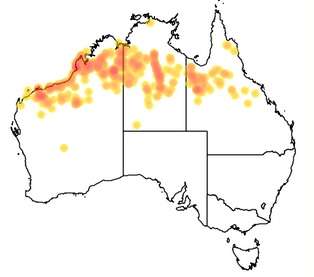Difference between revisions of "Category:DMT"
Endlessness (Talk | contribs) (→Pharmacology, toxicity and general safety) |
Endlessness (Talk | contribs) |
||
| Line 369: | Line 369: | ||
=== Mimosa === | === Mimosa === | ||
| − | |||
{{:Mimosa ophthalmocentra}} | {{:Mimosa ophthalmocentra}} | ||
Revision as of 19:38, 4 November 2011
http://wiki.dmt-nexus.me/Category:Alkaloids
Contents
- 1 Brief overview - What is DMT?
- 2 Chemical and physical properties
- 3 Effects
- 4 Pharmacology, toxicity and general safety
- 5 Plants containing DMT
- 6 General Plant Info
- 7 Geographic distribution
- 8 Identification
- 9 Alkaloid content
- 10 Other uses
- 11 Extraction
- 12 Cultivation
- 13 Suppliers
- 14 Links
- 15 References
- 16 Extraction Teks
- 17 Dosages and consumption methods
- 18 History of usage
- 19 Scientific publications
- 20 Links of interest
Brief overview - What is DMT?
NN-Dimethyltryptamine or DMT for short is an short acting psychedelic entheogen which allows a persons consciousness to voyage into the most incredible dimensions, visions, thoughts and experiences imaginable.
It is without doubt one of the most powerful yet mysterious psychedelics in existence but to classify DMT as merely a drug would be doing it a great injustice as DMT is more a trans dimensional key into places and vistas so profound and awe inspiring that it raises many new questions regarding the nature of reality and our place within it.
DMT exists naturally in every human being and also throughout the plant and animal kingdoms. It occurs naturally in many mammals, marine animals, trees, grasses, flowers and shoots.
DMT is closely related to serotonin, the naturally occurring neurotransmitter that psychedelics affect so widely. The pharmacology of DMT is similar to that of other well-known psychedelics. It affects receptor sites for serotonin in much the same way that LSD, psilocybin, and mescaline do. These serotonin receptors are widespread throughout the body and can be found in blood vessels, muscle, glands, and skin.
There are a number of ways to acquire this entheogen. The first and most difficult way is to have some substantial chemistry knowledge and experience and actually synthesize pure DMT in a laboratory. This a rather tricky and time consuming process and requires access to some rather obscure and hard to acquire chemicals.
The most common and easiest method to acquire DMT is to extract it from the various plant species that contain the compound. The various plants and extraction techniques can be found on this wiki at the extraction teks.
Chemical and physical properties
DMT = N,N-Dimethyltryptamine
Freebase DMT
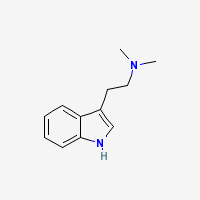 |
- Appearance: White/Transparent crystals
- CAS Registry Number: 61-50-7
- Composition: C12H16N2
- Molecular Weight: 188.26884 g/mol
- Melting point: 44-68°C (Conflicting reports in literature, as mentioned in TIHKAL)
- Boiling point: Theoretically 360-380°C
- XLogP: 2.0
- XLogP3: 2.5 (PubChem)
- pKa: 8.68 (Merck Index)
- Colorimetric reagent results: Here
- Stability/Degradation: Oxidation to DMT N-Oxide (yellow oil) in extended presence of oxygen (specialy in evaporation of dmt-containing solvents with heat and/or fan or generally in prolonged exposure to open air). N-oxide may be reverted back to the parent compound by reduction, as described in the N-Oxide to Freebase Wiki.
- Solubility:
Very Soluble in Xylene, Toluene, Limonene, acetone, Isopropyl Alcohol (IPA), methanol, ethanol, Dichloromethane (DCM), chloroform, ether, Butanone (also known as methyl ethyl ketone (MEK)) and butanol.
Soluble in naphtha, hexane, heptane but almost insoluble in these solvents at freezing temperatures
Almost insoluble in water.
DMT N-Oxide
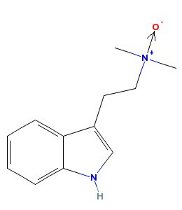 |
- Appearance: Yellow oil
- XLogP3: 2
- Colorimetric reagent results: Here
- Solubility:
Soluble in Xylene, Toluene, Limonene
Slightly soluble in basic water
Insoluble in naphtha
DMT Fumarate
- Molecular Weight: 492.608 g/mol
- Solubility:
Very soluble in water
Soluble in methanol (~10mg/ml)
Soluble in boiling IPA, Practically insoluble in room temp IPA (~1mg/ml), Insoluble in freeze-cold IPA.
Slightly soluble in ethanol (~5mg/ml)
Insoluble in cold acetone
Insoluble in FASI (Fumaric Acid Saturated IPA)
Insoluble in FASA (Fumaric Acid Saturated Acetone)
Effects
Depending on the dosage, the effects of DMT can range from a multitude of sensations, from bizarre, beautiful and even 'impossible' visions to literally jaw hanging awe as one is propelled into other dimensions of existence where human language and logic cannot even begin to describe or comprehend.
There have been a few attempts to define different levels and types of experience. Psychedelic Monographs and Essays[1] discusses different levels of a DMT experience.
The Hyperspace Lexicon project is an attempt to create a new vocabulary to try to describe the DMT realm
Pharmacology, toxicity and general safety
For info on DMT safety, please reffer to Health and Safety section
Plants containing DMT
The following is a list of plants known to contain tryptamines.
Acacia
| Acacia acuminata |
|
|---|---|
| Up to 1.8% alkaloids, mainly consisting of dimethyltryptamine in bark (Jeremy EGA conference, Australia 2009, used successfully in S.Australia since c.2008); up to 1.2% DMT phyllode (leaf) (DMT-Nexus); tryptamine in leaf (White et al 1951) |
| Acacia alpina |
|
|---|---|
| Active principles (mainly DMT) in leaf (M.Bock) |
| Acacia angustifolia |
|
|---|---|
| Psychoactive Tryptamines (Rätsch 2004) |
| Acacia angustissima |
|
|---|---|
| β-methyl-phenethylamine (Glasby 1991)NMT and DMT in leaf, 1.2-2.8 ppm (McSweeney et al. 2005) |
| Acacia auriculiformis |
|
|---|---|
| 5-MeO-DMT in stem bark (Lycaeum) |
| Acacia baileyana |
|
|---|---|
|
| Acacia berlandieri |
|
|---|---|
|
| Acacia catechu |
|
|---|---|
|
| Acacia caven |
|
|---|---|
|
[[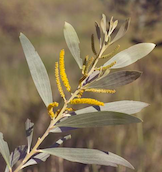 |center|100x100px]] |center|100x100px]] |
Acacia colei |
|---|---|
| DMT (Dr. Karl and abc.net.au 2005) 1%+ in bark (different net reports) |
</onlyinclude>
General Plant Info
Acacia colei is a perennial bush or tree native to Australia and southern Asia. A common name for it is Cole's Wattle. It grows to a height of up to 9 m. Acacia colei blooms from June through July and the flowers are bright yellow.[2]
Consists of 2 variants:
Geographic distribution
Identification
Phyllodes are 10-19 cm long and 20-55 mm wide, usually with three prominent longitudinal nerves. A dense covering of short hairs on the phyllodes gives the plant a characteristic silvery-blue appearance.
Alkaloid content
Claimed to contain 1.8% or more DMT in bark [3] [4], 0.2-0.6% in leaf. Needs further research.
Other uses
Its uses include environmental management, forage and wood. The seeds are good-tasting[5] and are potentially useful as food for humans. The results of tests in Nigeria for the feasibility of raising the tree as a drought-resistant food crop came out very positively.[6]
Extraction
Cultivation
Suppliers
Links
References
- ↑ Psychedelic Monographs and Essays [1]
- ↑ Australian Biological Resources Study
- ↑ Dr. Karl Kruszelnicki ABC Radio
- ↑ Seldom/nen888 DMT Nexus
- ↑ ECHO Education Concerns for Hunger Organization
- ↑ World Wide Wattle
| Acacia complanata |
|
|---|---|
|
| Acacia constricta |
|
|---|---|
|
| Acacia confusa |
|
|---|---|
|
| Acacia cornigera |
|
|---|---|
|
| Acacia cultriformis |
|
|---|---|
|
| Acacia farnesiana |
|
|---|---|
|
| Acacia filiciana |
|
|---|---|
|
| Acacia floribunda |
|
|---|---|
|
| Acacia georginae |
|
|---|---|
|
| Acacia greggii |
|
|---|---|
|
| Acacia harpophylla |
|
|---|---|
|
| Acacia holoserica |
|
|---|---|
|
| Acacia horrida |
|
|---|---|
|
| Acacia implexa |
|
|---|---|
|
| Acacia karroo |
|
|---|---|
|
| Acacia kempeana |
|
|---|---|
|
| Acacia kettlewelliae |
|
|---|---|
|
| Acacia laeta |
|
|---|---|
|
| Acacia lingulata |
|
|---|---|
|
| Acacia longifolia |
|
|---|---|
|
| Acacia macradenia |
|
|---|---|
|
| Acacia maidenii |
|
|---|---|
|
| Acacia mangium |
|
|---|---|
|
| Acacia melanoxylon |
|
|---|---|
|
| Acacia mellifera |
|
|---|---|
|
| Acacia nilotica |
|
|---|---|
|
{{botanics_info|image:NoImage.png|Acacia obtusifolia|
- 0.4 to 0.5 % DMT/NMT in the dried bark (Csiro 1990)
- 0.15-0.6% DMT,NMT(2:1)plus trace betacarboline in bark, 0.06-0.2% leaves (Southern Cross University comissioned test 2001)
- 5-MeoDMT & bufotenine in some loctations (E., Entheogen Review 1995-6; Trout's Notes 2005-10) Is not fast growing in the wild and is under threat of serious overharvesting. Is NOT considered a weed as previously stated here, and will become rarer if wild seed populations exploited further.(Nen, original bioassay subject)
| Acacia oerfota |
|
|---|---|
|
| Acacia penninervis |
|
|---|---|
|
| Acacia phlebophylla |
|
|---|---|
|
| Acacia platensis |
|
|---|---|
|
| Acacia podalyriaefolia |
|
|---|---|
|
| Acacia polyacantha |
|
|---|---|
|
| Acacia pycantha |
|
|---|---|
|
| Acacia retinodes |
|
|---|---|
|
| Acacia roemeriana |
|
|---|---|
|
| Acacia rigidula |
|
|---|---|
|
| Acacia salicina |
|
|---|---|
|
| Acacia sassa |
|
|---|---|
|
| Acacia schaffneri |
|
|---|---|
|
| Acacia schottii |
|
|---|---|
|
| Acacia senegal |
|
|---|---|
|
| Acacia simplex |
|
|---|---|
|
| Acacia taxensis |
|
|---|---|
|
| Acacia tenuifolia |
|
|---|---|
|
| Acacia tortilis |
|
|---|---|
|
| Acacia sieberiana |
|
|---|---|
|
| Acacia verek |
|
|---|---|
|
| Acacia vestita |
|
|---|---|
|
Anadenanthera
| Anadenanthera colubrina |
|
|---|---|
|
| Anadenanthera macrocarpa |
|
|---|---|
|
| Anadenanthera peregrina |
|
|---|---|
| Tryptamines known to be present in A. peregrina [1] Bufotenine (seeds)Bufotenine N-oxide (seeds)N,N-Dimethyltryptamine N-oxide (seeds)N,N-Dimethyltryptamine (bark)(pods)(seeds)5-Methoxy-N-methyltryptamine (bark)O-Methylbufotenine (bark) (seeds)N-Methyltryptamine (bark) |
Common Reed
| Arundo donax |
|
|---|---|
| Entire Plant contains 5-MeO-DMT (Shulgin, TIHKAL)Flowers contain DMT, 5-MeO-DMT, and 5-MeO-NMT (Shulgin, TIHKAL)Roots contain DMT, 5-MeO-DMT, 5-MeO-NMT, Bufotenine, bufotenidine, dehydrobufotenidine (Shulgin, TIHKAL) |
| Desmanthus illinoensis |
|
|---|---|
| Root contains DMT - 0.200% (Ott)Root Bark contains DMT - 0.340% (Ott) |
| Phalaris arundinacea (Reed Canary Grass) |
|
|---|---|
| Leaves contain DMT, 5-MeO-DMT, and related compounds (Smith 1977) 0.0004-0.121% Total Alkaloids (Dried) Lycaeum (DMT, Life and the Universe) |
| Phalaris tuberosa |
|
|---|---|
| Leaves and seedlings contain DMT, 5-MeO-DMT, and related compounds (Smith 1977)DMT - 0.100% (erowid)5-MeO-DMT - 0.022% (erowid)5-OH-DMT - 0.005% (erowid) |
| Phragmites australis (Common Reed) |
|
|---|---|
| DMT in roots (Ott) |
Delosperma
| Delosperma acuminatum |
|
|---|---|
| DMT, 5-MEO-DMT (Trout's Notes) |
| Delosperma cooperi |
|
|---|---|
| DMT, 5-MEO-DMT (Trout's Notes) |
| Delosperma ecklonis |
|
|---|---|
| DMT (Trout's Notes) |
| Delosperma esterhuyseniae |
|
|---|---|
| DMT (Trout's Notes) |
| Delosperma hallii |
|
|---|---|
| 5-MEO-DMT (Trout's Notes) |
| Delosperma harazianum |
|
|---|---|
| DMT, 5-MEO-DMT (Trout's Notes) |
| Delosperma hirtum |
|
|---|---|
| DMT (Trout's Notes) |
| Delosperma lydenbergense |
|
|---|---|
| DMT, 5-MEO-DMT (Trout's Notes) |
| Delosperma nubigenum |
|
|---|---|
| 5-MEO-DMT (Trout's Notes) |
| Delosperma pageanum |
|
|---|---|
| DMT, 5-MEO-DMT (Trout's Notes) |
| Delosperma pergamentaceum |
|
|---|---|
| Traces of DMT (Trout's Notes) |
| Delosperma tradescantioides |
|
|---|---|
| DMT (Trout's Notes) |
Desmodium
| Desmodium caudatum |
|
|---|---|
|
| Desmodium gangeticum |
|
|---|---|
|
| Desmodium gyrans |
|
|---|---|
|
| Desmodium pulchellum |
|
|---|---|
|
| Desmodium racemosum |
|
|---|---|
|
| Desmodium triflorum |
|
|---|---|
|
| Lespedeza bicolor |
|
|---|---|
var. japonica
|
Petalostylis
| Petalostylis cassioides |
|
|---|---|
| 0.4-0.5% tryptamine, DMT, etc. in leaves and stems (Johns et al 1966) |
Mimosa
| Mimosa ophthalmocentra (Red Jurema
) |
|
|---|---|
|
1,6% DMT in the inner rootbark [2] |
| Mimosa scabrella |
|
|---|---|
|
| Mimosa verrucosa |
|
|---|---|
|
| Mucuna pruriens |
|
|---|---|
|
| Petalostylis labicheoides |
|
|---|---|
var. casseoides
|
| Diplopterys cabrerana (Chaliponga
) |
|
|---|---|
|
| Horsfieldia superba |
|
|---|---|
|
| Iryanthera ulei |
|
|---|---|
|
| Osteophloem platyspermum |
|
|---|---|
|
Virola
| Virola calophylla |
|
|---|---|
|
| Virola carinata |
|
|---|---|
|
| Virola divergens |
|
|---|---|
|
| Virola elongata |
|
|---|---|
|
| Virola melinonii |
|
|---|---|
|
| Virola multinervia |
|
|---|---|
|
| Virola pavonis |
|
|---|---|
|
| Virola peruviana |
|
|---|---|
|
| Virola rufuta |
|
|---|---|
|
| Virola sebifera |
|
|---|---|
|
| Virola theiodora |
|
|---|---|
|
| Virola venosa |
|
|---|---|
|
| Psychotria carthaginensis |
|
|---|---|
|
| Psychotria viridis (Chacruna
) |
|
|---|---|
|
Extraction Teks
A/B
STB
STB-A/B hybrid
Dry tek
Dosages and consumption methods
History of usage
Scientific publications
Links of interest
Cite error: <ref> tags exist, but no <references/> tag was found
Pages in category "DMT"
The following 40 pages are in this category, out of 40 total.





